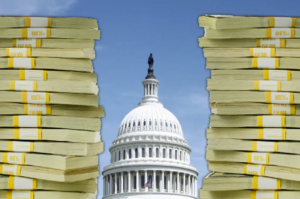By Eric Ramputh

Towards the latter part of 2023, no earlier than the third quarter of the year, America’s debt ceiling clock will strike midnight. At that time, the country will face two potential outcomes.[1] The first outcome would be all too familiar, as Congress would avert another debt ceiling crisis and kick the debt ceiling “can” down the road for yet another future Congress to deal with. The second – unthinkable – outcome is that Congress will fail to raise the debt limit and cause America to default on its debt for the first time in history. Such an outcome would unleash an economic catastrophe upon the American people and the global economy. In fact, Moody’s Analytics projected that a U.S. debt default would result in as much as 6 million jobs lost, an erasure of $15 trillion in household wealth, and a new recession.[2]
The debt ceiling originated in 1917 when Congress enacted legislation that placed a debt limit on “combined debt issues.”[3] Over two decades later, in 1941, Congress created the “modern debt ceiling.”[4] Specifically, the “Debt Limit” is “the total amount of money that the United States government is authorized to borrow to meet its existing legal obligations, including Social Security and Medicare benefits, military salaries, interest on the national debt, tax refunds, and other payments[5].” In the past sixty-two years, Congress has “raised,” “extended,” or “revised the definition” of the debt ceiling 78 times, to ensure the full faith and credit of the United States.[6]
However, the debt ceiling has taken on a new light in the modern era of hyperpolarized and scorched earth politics that dominate America. Unlike decades past, when policymakers in both parties recognized an obligation to raise the debt ceiling and ensure the full faith and credit of the country, a new breed of ideologically extreme politicians has emerged. Instead of approaching the debt ceiling as an obligation to be met, these ideologues view it as an economic weapon of mass destruction to be leveraged against their political adversaries for policy concessions.
To be clear, using the debt-ceiling as leverage is not an entirely new phenomenon. In 2011 and 2013, during the Obama Administration, House and Senate Republicans weaponized the debt-ceiling with the hope of extracting painful political concessions from the then president, in the form of fiscal spending cuts.[7] However, President Obama wisely refused to negotiate on the debt-ceiling – calling such negotiations as under the guise of “a gun at the head of the American people” – and separate compromises were eventually reached.[8] During the Trump Administration, unlike the Obama years, no such debt-ceiling brinksmanship occurred. Despite $7.8 trillion in new spending over the decade during the Trump presidency – more spending than either of the eight-year terms of Presidents Bush and Obama – the routine brinksmanship employed by House and Senate Republicans disappeared.[9] In that time, three debt-ceiling increases passed the House and Senate with large bipartisan majorities, and with no concerted threat to the full faith and credit of the U.S. government.[10]
Unsurprisingly, with the transition from the Trump to Biden Administration, House and Senate Republicans rediscovered the debt-ceiling brinksmanship they had forgotten during the Trump years. Consequently, the prior bipartisan consensus vanished, and both debt-ceiling votes during the Biden Administration have passed with slim Democrat-led majorities.[11] Approaching a new debt ceiling deadline and emboldened by their incoming majority in the House, Republicans have made their bargaining points clear. House Republican Leader Kevin McCarthy, the potential incoming Speaker of the House, has stated that a vote to raise the debt ceiling by his caucus is contingent on “various changes to federal law.”[12] These changes presumably include changes to the major entitlement programs – Social Security and Medicare – and other Biden Administration priorities.[13]
Ultimately, the path forward on the debt-ceiling should include eliminating the need for any future debt-ceiling crises. During the remainder of the lame duck session, congressional Democrats and Republicans (who recognize the danger of a debt ceiling default) should come together to eliminate the debt ceiling altogether. America is one of two Western countries, Denmark being the other, that even have a debt-ceiling to begin with.[14] There is no objective reason for Congress to provide political ideologues and arsonists with the means to impose an economic calamity on the American people, in the name of politics. For the American people, the full faith and credit of the country, and the future prosperity of the nation, Congress must diffuse the ticking time bomb at the center of the American economy. A failure to do so would be an extraordinary failure of leadership. America deserves better.
[1] Erin Meade, Debt Limit “X Date” Further Out Than Expected, But Still Looms Ahead, Bipartisan Pol’y Ctr. (Jun. 14, 2022), https://bipartisanpolicy.org/press-release/debt-limit-x-date-further-out-than-expected-but-still-looms-ahead/.
[2] Aimee Picchi, U.S. Debt Default Could Wipe out 6 Million Jobs and $15 Trillion in Wealth, Moody’s says, CBS News (Sep. 22, 2021), https://www.cbsnews.com/news/debt-ceiling-default-6-million-jobs-15-trillion-wealth/.
[3] H. Comm. on the Budget, The Debt Ceiling: An Explainer, (Feb. 11, 2022), chrome-extension://efaidnbmnnnibpcajpcglclefindmkaj/https://budget.house.gov/sites/democrats.budget.house.gov/files/documents/The%20Debt%20Ceiling%20An%20Explainer.pdf.
[4] Id.
[5] U.S. Dep’t of the Treasury, Debt Limit, (2022), https://home.treasury.gov/policy-issues/financial-markets-financial-institutions-and-fiscal-service/debt-limit.
[6] Id.
[7] Molly E. Reynolds & Phillip A. Wallach, The Fiscal Fights of the Obama Administration, Brookings (Dec. 8, 2016, https://www.brookings.edu/research/the-fiscal-fights-of-the-obama-administration/.
[8] Mark Felsenthal & Matt Spetalnick, Obama Digs Heels In, Refuses to Negotiate Debt Ceiling, Reuters (Jan. 14, 2013), https://www.reuters.com/article/us-usa-obama-debt/obama-digs-heels-in-refuses-to-negotiate-debt-ceiling-idUSBRE90D0UK20130114.
[9] Brian Riedl, Trump’s Fiscal Legacy: A Comprehensive Overview of Spending, Taxes, and Deficits, Manhattan Inst. (May 12, 2022), https://www.manhattan-institute.org/trumps-fiscal-legacy.
[10] Justin Murray, Cong. Rsch. Serv., R41814, Votes on Measures to Adjust the Statutory Debt Limit, 1978 to Present (2022).
[11] Id.
[12] Jeff Stein & Marianna Sotomayor, GOP Debt Ceiling Threats Set to Revive Brinkmanship with White House, Wash. post (Oct. 25, 2022), https://www.washingtonpost.com/us-policy/2022/10/25/gop-debt-ceiling-threats-set-revive-brinkmanship-with-white-house/.
[13] Id.
[14] Roger W. Ferguson Jr., What’s at Stake in the Debt Ceiling Showdown, Council on Foreign Relations (Sep. 28, 2021), https://www.cfr.org/in-brief/whats-stake-debt-ceiling-showdown.

